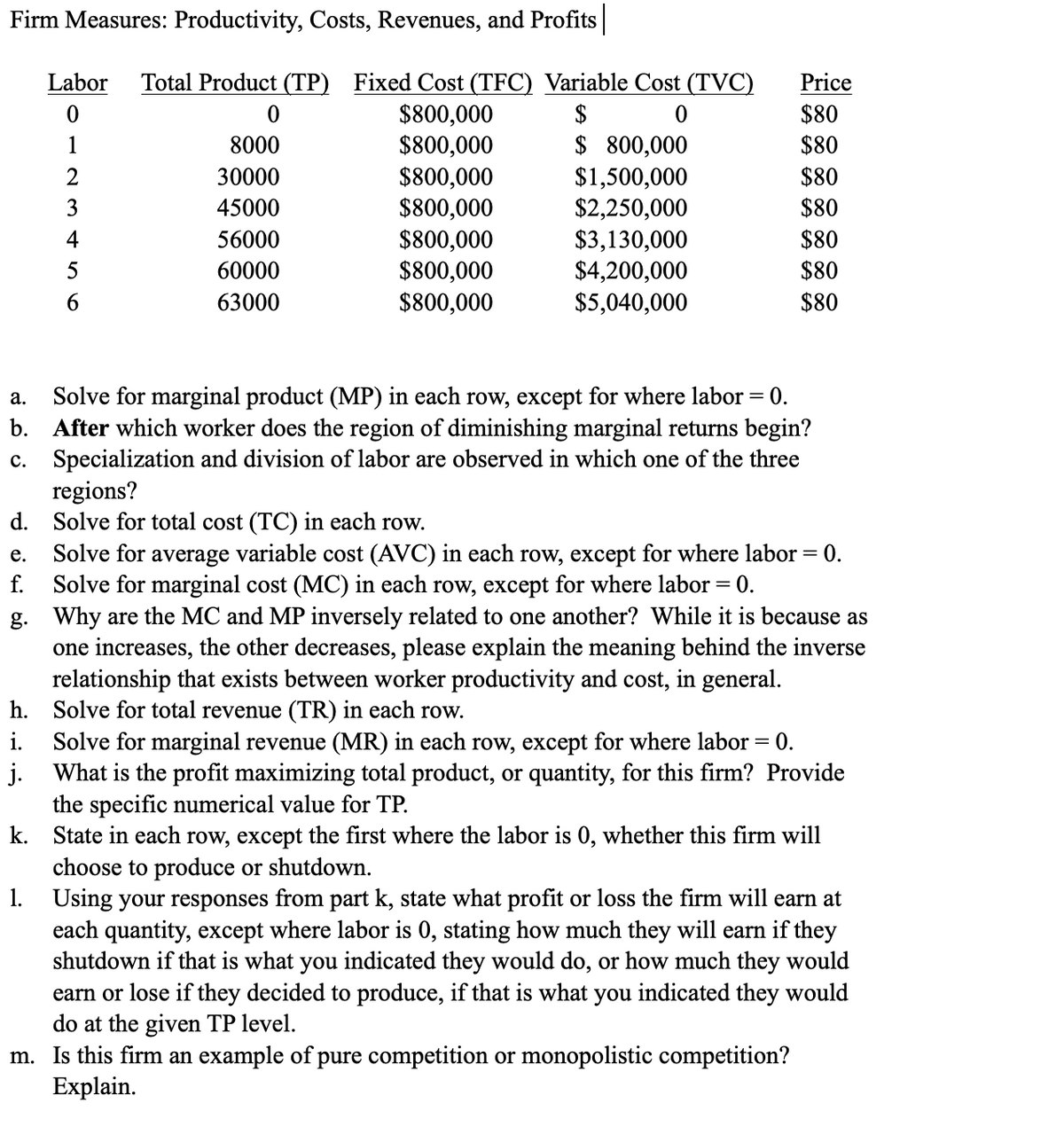Firm Measures: Productivity, Costs, Revenues, and Profits Labor Total Product (TP) Fixed Cost (TFC) Variable Cost (TVC) $800,000 $ 0 $800,000 $ 800,000 $800,000 $1,500,000 $800,000 $2,250,000 $800,000 $3,130,000 $800,000 $4,200,000 $800,000 $5,040,000 0 1 2 3 4 5 6 0 8000 30000 45000 56000 60000 63000 Price $80 $80 $80 $80 $80 $80 $80 a. Solve for marginal product (MP) in each row, except for where labor = 0. b. After which worker does the region of diminishing marginal returns begin? c. Specialization and division of labor are observed in which one of the three regions?
Firm Measures: Productivity, Costs, Revenues, and Profits Labor Total Product (TP) Fixed Cost (TFC) Variable Cost (TVC) $800,000 $ 0 $800,000 $ 800,000 $800,000 $1,500,000 $800,000 $2,250,000 $800,000 $3,130,000 $800,000 $4,200,000 $800,000 $5,040,000 0 1 2 3 4 5 6 0 8000 30000 45000 56000 60000 63000 Price $80 $80 $80 $80 $80 $80 $80 a. Solve for marginal product (MP) in each row, except for where labor = 0. b. After which worker does the region of diminishing marginal returns begin? c. Specialization and division of labor are observed in which one of the three regions?
Managerial Economics: A Problem Solving Approach
5th Edition
ISBN:9781337106665
Author:Luke M. Froeb, Brian T. McCann, Michael R. Ward, Mike Shor
Publisher:Luke M. Froeb, Brian T. McCann, Michael R. Ward, Mike Shor
Chapter4: Extent (how Much) Decisions
Section: Chapter Questions
Problem 4.2IP
Related questions
Question

Transcribed Image Text:Firm Measures: Productivity, Costs, Revenues, and Profits
Labor Total Product (TP) Fixed Cost (TFC) Variable Cost (TVC)
$800,000
$
0
$800,000
$ 800,000
$800,000
$800,000
d.
e.
f.
g.
0
1
2
4
5
6
1.
0
8000
30000
45000
56000
60000
63000
$800,000
$800,000
$800,000
$1,500,000
$2,250,000
$3,130,000
$4,200,000
$5,040,000
a.
Solve for marginal product (MP) in each row, except for where labor = 0.
b. After which worker does the region of diminishing marginal returns begin?
c. Specialization and division of labor are observed in which one of the three
Price
$80
$80
$80
$80
$80
$80
$80
regions?
Solve for total cost (TC) in each row.
Solve for average variable cost (AVC) in each row, except for where labor = 0.
Solve for marginal cost (MC) in each row, except for where labor = 0.
Why are the MC and MP inversely related to one another? While it is because as
one increases, the other decreases, please explain the meaning behind the inverse
relationship that exists between worker productivity and cost, in general.
Solve for total revenue (TR) in each row.
h.
j.
i. Solve for marginal revenue (MR) in each row, except for where labor = 0.
What is the profit maximizing total product, or quantity, for this firm? Provide
the specific numerical value for TP.
k.
State in each row, except the first where the labor is 0, whether this firm will
choose to produce or shutdown.
Using your responses from part k, state what profit or loss the firm will earn at
each quantity, except where labor is 0, stating how much they will earn if they
shutdown if that is what you indicated they would do, or how much they would
earn or lose if they decided to produce, if that is what you indicated they would
do at the given TP level.
m. Is this firm an example of pure competition or monopolistic competition?
Explain.
Expert Solution
This question has been solved!
Explore an expertly crafted, step-by-step solution for a thorough understanding of key concepts.
Step by step
Solved in 4 steps

Knowledge Booster
Learn more about
Need a deep-dive on the concept behind this application? Look no further. Learn more about this topic, economics and related others by exploring similar questions and additional content below.Recommended textbooks for you

Managerial Economics: A Problem Solving Approach
Economics
ISBN:
9781337106665
Author:
Luke M. Froeb, Brian T. McCann, Michael R. Ward, Mike Shor
Publisher:
Cengage Learning

Managerial Economics: A Problem Solving Approach
Economics
ISBN:
9781337106665
Author:
Luke M. Froeb, Brian T. McCann, Michael R. Ward, Mike Shor
Publisher:
Cengage Learning